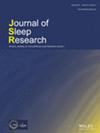Associations between real‐life light exposure patterns and sleep behaviour in adolescents
IF 3.4
3区 医学
Q2 CLINICAL NEUROLOGY
引用次数: 0
Abstract
SummaryOne of the most striking changes in the regulation of sleep–wake behaviour during adolescence is circadian phase delay. Light exposure synchronises circadian rhythms, impacting sleep regulation, however, the influence of real‐life light exposure on sleep variations remains less clear. We aimed to describe the sleep and light exposure patterns of high school students with comparable schedules and socio‐economic backgrounds, and to evaluate whether there was any association between them, considering chronotype. We analysed five school days and two free days of actigraphy records, from 35 adolescents (24 female, mean age: 16.23 ± 0.60). The sample was described using the Sleep Regularity Index (SRI), chronotype (actigraphy MSFsc), and self‐reported diurnal preference (Morning/Evening Scale). Regression models were constructed to assess the impact of light exposure (daytime and nighttime) on subsequent sleep episodes; and to confirm whether the associations could be an indirect consequence of chronotype. Despite following similar routines, the SRI varied considerably (48.25 to 88.28). There was compatibility between the actigraphy proxy for chronotype and the self‐reported diurnal preference, extracted using the circadian rhythm scale for adolescents. Less light exposure during the day was associated with later sleep onset and shorter sleep duration. An increase of 100 lux in average daytime light exposure advance of 8.08 minutes in sleep onset and 7.16 min in sleep offset. When the regressions were controlled for chronotype, these associations persisted. These findings facilitate discussions regarding the behavioural aspect of the impact of real‐life light exposure on sleep and its potential as a target for interventions aiming to enhance adolescents’ sleep quality.现实生活中的光照模式与青少年睡眠行为之间的关系
摘要青春期睡眠-觉醒行为调节中最显著的变化之一是昼夜节律相位延迟。光照可使昼夜节律同步,从而影响睡眠调节,然而,现实生活中的光照对睡眠变化的影响仍不太清楚。我们的目的是描述具有相似作息时间和社会经济背景的高中生的睡眠和光照模式,并在考虑昼夜节律的情况下评估两者之间是否存在关联。我们分析了 35 名青少年(24 名女性,平均年龄:16.23 ± 0.60)在校五天和空闲两天的行为记录。我们使用睡眠规律指数(SRI)、时序类型(动图 MSFsc)和自我报告的昼夜偏好(早/晚量表)对样本进行了描述。我们建立了回归模型,以评估光照(白天和夜间)对后续睡眠发作的影响,并确认这些关联是否可能是时序型的间接结果。尽管他们的作息时间相似,但 SRI 差异很大(从 48.25 到 88.28)。行为记录仪代表的时间型与使用青少年昼夜节律量表提取的自我报告的昼夜偏好之间具有兼容性。白天光照较少与睡眠开始时间较晚和睡眠持续时间较短有关。白天平均光照增加 100 勒克斯,睡眠开始时间提前 8.08 分钟,睡眠偏移时间提前 7.16 分钟。在对时间类型进行回归控制后,这些关联依然存在。这些发现有助于讨论现实生活中光线照射对睡眠的行为影响,以及将其作为旨在提高青少年睡眠质量的干预目标的潜力。
本文章由计算机程序翻译,如有差异,请以英文原文为准。
求助全文
约1分钟内获得全文
求助全文
来源期刊

Journal of Sleep Research
医学-临床神经学
CiteScore
9.00
自引率
6.80%
发文量
234
审稿时长
6-12 weeks
期刊介绍:
The Journal of Sleep Research is dedicated to basic and clinical sleep research. The Journal publishes original research papers and invited reviews in all areas of sleep research (including biological rhythms). The Journal aims to promote the exchange of ideas between basic and clinical sleep researchers coming from a wide range of backgrounds and disciplines. The Journal will achieve this by publishing papers which use multidisciplinary and novel approaches to answer important questions about sleep, as well as its disorders and the treatment thereof.
 求助内容:
求助内容: 应助结果提醒方式:
应助结果提醒方式:


